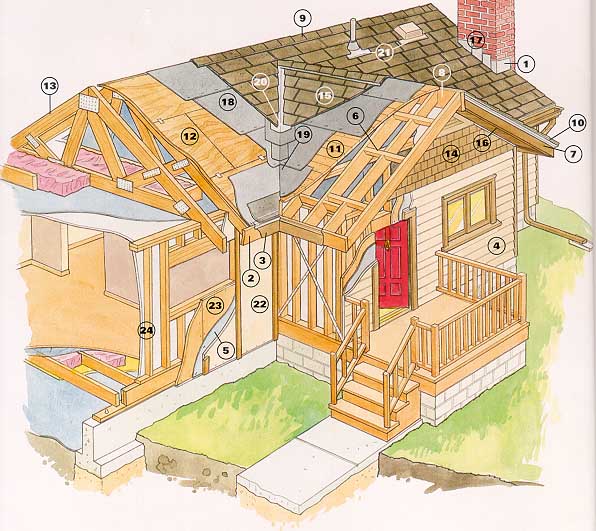A roof is one of the most essential parts of your home, that keeps it safe and protected from adverse natural elements.If you are thinking of replacing your old roof, it is important to have a general sense of roof construction. This information will help you be a more discerning consumer, and will assist you in dealing with contractors, so that you can get the best roofing products that suite your budget and needs.
A roofing system consists of several parts that are constructed in a step by step process. Each component of the system is described below, from the rafters that come first to the skylights and chimneys that sit on top of the complete roof.
Roof Construction Video
1. Rafters
A rafter is one member in a series of sloped beams that are designed to support the roof deck and its associated loads. Rafters are typically made of wood and exposed rafters can be a feature of traditional roof styles. In modern construction, there is a preference for trussed rafters, which are made of one or more triangular units constructed with straight members, whose ends are connected at joints. Trussed rafters are manufactured off-site, use less materials, are easier to construct and therefore cost less than traditional rafters.

2. Deck / Substrate
A roof deck is a roofing material layer installed on top of the rafters and right under the insulating layers of underlayment. The primary function of a deck is to act as a unifying structural diaphragm by tying all the components of a roof together. In construction, a roof deck is also known as sheathing or substrate. All three terms refer to the same thing. A deck can be made from plywood, OSB/boards. A high quality roof deck must be rigid, should eliminate excessive positive or negative deflection under load, and needs to have a smooth surface free of any large cracks or gaps. It is critical for the deck to be evenly and securely anchored to the building structure. It must have a proper water drainage system, without which a roof performance will be compromised, if it is exposed to prolonged periods of ponding water.
3. Underlayment
Roofing underlayment is a special barrier that is installed between the deck/substrate and the surface material, such as roofing shingles, tile, etc. Underlayment is installed in an overlapping sequence from the bottom of the roof, going up. It provides added protection to the structure and the interior of the home against leaks, caused by rain and ice dams. There are three types of underlayment: felt, ice shield and synthetic underlayment. Felt underlayment is tar or asphalt saturated paper made with some fiberglass. Its the cheapest underlayment available, but it does not perform as well or last as long as other types of underlayment.
Ice shield underlayment is also known as Ice and Water Shield or I&W. It is a thick asphalt or bitumen based reinforced membrane that has a sticky surface, that adheres to the substrate. This membrane does not tear.In Northern states and Canada, building codes require the usage of I&W. This shield protects the roof from ice dams. For the best performance it should installed at the bottom 3 ft of the roof. The rest of the roof can be covered by regular underlayment (felt or synthetic).
Synthetic underlayment is an expensive substitute for felt. It lasts longer, is more tear proof, usually does not deteriorate, can be breathable or non-breathable. Non-breathable underlayment acts as a vapor barrier, meaning it traps moisture under the roof. This is bad because it makes the substrate rot and also causes the formation of allergenic mold and mildew. Read more about different types and uses of roofing underlayment here.
4.Roofing Material
Roofing material is nailed over the underlayment to the substrate. There are a wide variety of roofing materials available to homeowners that range in durability, longevity, level of protection, aesthetic look and design, as well as price. Materials include asphalt shingles, metal shingles, synthetic slate shingles, cedar shingles, clay and concrete tile, standing seam metal panels, EPDM, TPO and PVC membranes, copper materials, etc.
Asphalt shingles are a cheap material that is widely used in residential roofing, while metal and tile roofs are premium materials that are very costly, but offer superior lifetime protection and energy savings for your home.
5.Dormers
A dormer is a structural element of a building that protrudes from the plane of a sloping roof surface. They can be used in original construction or be added on later. They create extra usable space in the roof by adding headroom as well as allowing the addition of windows. If a dormer is not properly constructed it can lead to leaks and very expensive repairs. There are different types of dormers: shed, gabled, hipped, eyebrow, segmental. The most common types are gabled and hipped. A Gable dormer has a gabled roof, with two sloping planes that meet at a central ridge. A Hipped dormer has a hipped roof with three sloping planes that meet at the top.
6.Valleys
A valley is formed when two portions of a roof meet at an inside angle. These valleys are common to many roofs. Many times, a valley is created where the roof on the main part of the house meets the one on the garage, or when an addition is put on the original roof. A valley is a vulnerable area on the roof, as it can collect leaves, and other debris. In the winter, ice collects in the valley, and as the ice freezes and thaws, the shingles get worn down and often require repair or replacement.
7. Skylights, chimneys and other protrusions
Skylights, chimneys and other protrusions are the top elements of the roof structure. A skylight is a structure that allows light on the roof to travel to the interior of a home. Skylights are useful in spaces that do not receive a lot natural daylight. They offer an environmentally friendly solution to brightening a home. Using natural light rather than electricity as a light source can save energy and reduce electricity bills.
A chimney is a vertical structure for venting combustion gases or smoke from a boiler, stove, furnace or fireplace to the outside atmosphere through the roof.
8. Roof Installation Costs
On most installations, you will not be dealing with framing or substrate, as those are usually associated with new homes. On existing homes, you may encounter framing and substrate repairs / replacement only if your roof suffered severe damages, due to prolonged leaks.
If you are faced with roof replacement, you can use our calculator to estimate roof replacement cost for most items listed above: new underlayment, plywood replacement, chimney and skylight flashing, etc.
|
Low End
$4837
Mid Range
$6046
High End
$7558
|
|
|


 See costs in your area
See costs in your area
This is a great article showing the average homeowner how things actually come together to make a home and how the components of lets say a 2000 sf structure hold 2 tons of roofing material over your head.